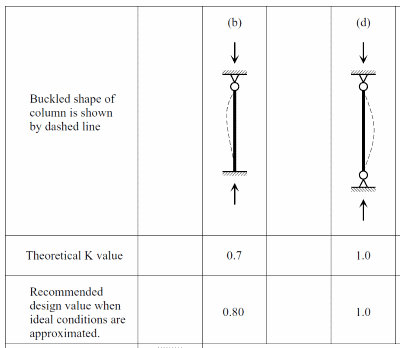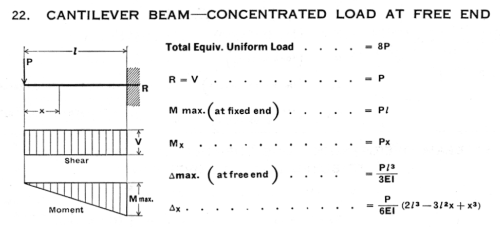Thanks for all the replies. Some followup questions/responses below:
@Dik & Coty: I can agree with this is most practical situations, but I am internally troubled that I can't confidently answer these questions in theory or based on codes.
@BAGW: I'd like to be able to answer the question based on principles of engineering and then figure out how to best apply any code. I know that a column with a fixed or semi fixed base has more axial capacity than one without. But how do we get there?
@Sliderule: Thanks for this. This is a pretty simple straight forward approach. Seems reasonalbe to me as well.
StevenH said:
Alternatively, model the column, footing and connection and run a buckling analysis might be an option
This is pretty generic statement, but I agree, this is the path I want to go down.
Kootk said:
It's not a simple question so feel no shame
I appreciate that. Interestingly enough I was in the middle of dusting off Mastran2, when I decided to refresh this page. I'm glad to see it seems I'm on the 'right' path.
Also I assume this is the thread with Josh's comment that you are referring to:
LINK
Sidenote - Mastan2 has a pretty good learning module series for anyone interested.
I think Kootk has elaborated on what Stevenh suggested and what I've started to do.
Here's what I did, please comment as you see fit:
I set up a model consisting of a single column in Mastran2 with boundary conditions as follows : Restrained in X-direction at the top of the column, restrained in X,Y and Rot about Z at the bottom of the column (X-Y in the plane of the column and Z out of page). For those playing along at home:
Height: 16'
Column: HSS 8x8x1/2
Fy: 46 ksi
E: 29000ksi
I segmented the column in to 8 elements. So you have 9 nodes.
I Applied a 100kip load to the top of the column
I ran an Elastic Critical Load Analysis (aka Buckling analysis or Eigenvalue analysis) using planar frame for my analysis type. This gave me the deformed shape to start with, it is some sort of sin wave shape (slightly different because of the fixed base). My load ratio was 19.86, so the elastic critical buckling load was 1986 kips.
In Mastan2 you can use this deformed shape as a starting point to perform a 2nd order analysis. So I selected node 7 which is near the center of the column (node 1 is bottom and node 2 is at the top) and offset this node equal to H/1000 (i.e. 16'/1000 = 0.192"). Mastan2 will then offset the rest of the nodes proportionally to that your starting geometry is in the shape of the "sin wave".
I then ran a 2nd Order Inelastic analysis with the 100 kip load applied, same boundary conditions and the column geometry was "bent" in the "sin wave" I described above. Additionally I selected a "E" as E_AISC which I believe accounts for residual stresses in the column, I'm not sure what the program actually uses though and can't seem to find this. My load increment was 0.01 and Max number of increments was 10,000 for the record.
(Side question - I still want to know why they settled on the name "2nd Order")
This resulted in a load factor of 5.54 (i.e. 554 kips) and a moment at the base of 226.2 kip*in or 18.85 kip*ft. In the results tab you can change your load factor and check the moment reaction at the base. So if you reduce the load factor to your actual applied axial load you will get your moment demand on the base plate.
Side Note:
I then checked the same column as pin-pin and got a LF of 4.91 (i.e. 491 kip). The AISC manual lists the capacity of an 8x8x1/2 as 284kip, 426kip respectively. So there is about 3.5% difference there. I also re-ran all the calcs using a deflected shape from pin-pin and redefining the base fixity and got basically the same results.
Getting back to the results:
The critical loads are 554 kips and your moment demand is 18.85 kip*ft (note that you should check the moment isn't higher at any other node).
So for ASD your allowable buckling load would be 554/1.67 = 331.7 kip
And moment capacity would be:
M.c = Z.x x F.y => 37.5in^3 x 46ksi /1.67 = 1032.9 kip*in
So lets say that you axial load is 300kips (ASD), if I reduce my load factor in Mastan2 so that I'm effectively applying 300kip to the column I get a moment of about 60kip-in in the column.
Check unity:
300/331.7 + 60/1032.9 = 0.96 OK//
I'm a little unsure about this last part (the design check). Does this seem correct?
The other question I have is regarding the stiffness of the base plate. I'm still not sure what this needs to be, I'm looking through a few texts and will post back with some thoughts.
Thanks Again!
EIT



![[idea] [idea] [idea]](/data/assets/smilies/idea.gif)
![[r2d2] [r2d2] [r2d2]](/data/assets/smilies/r2d2.gif)